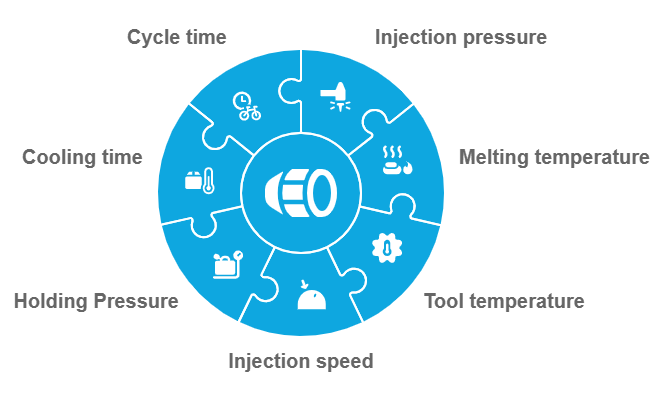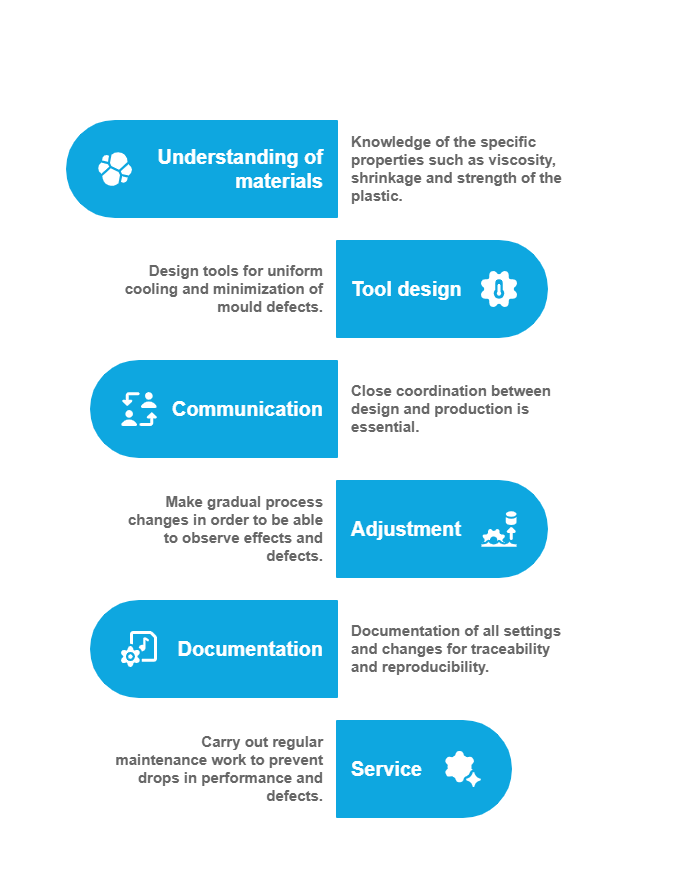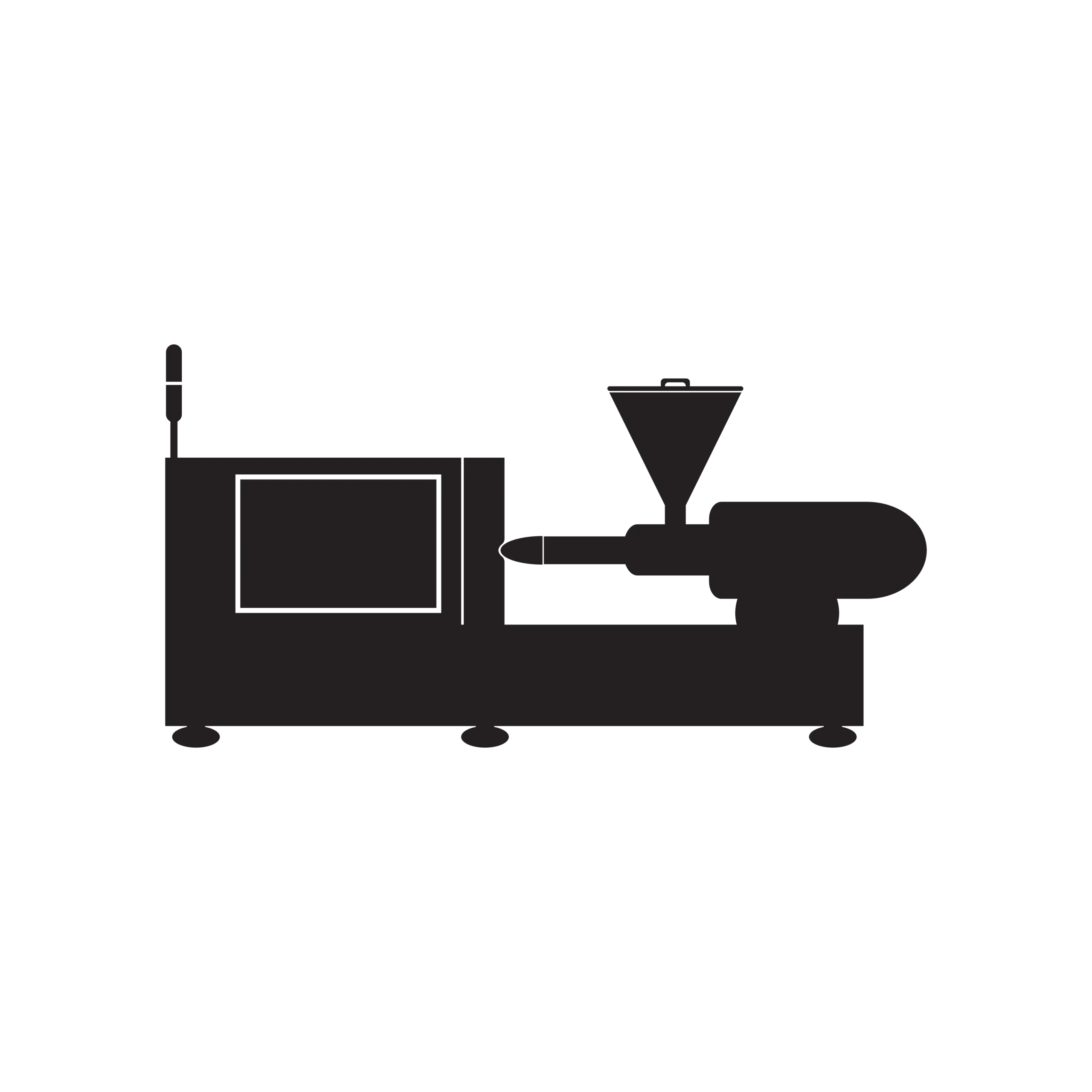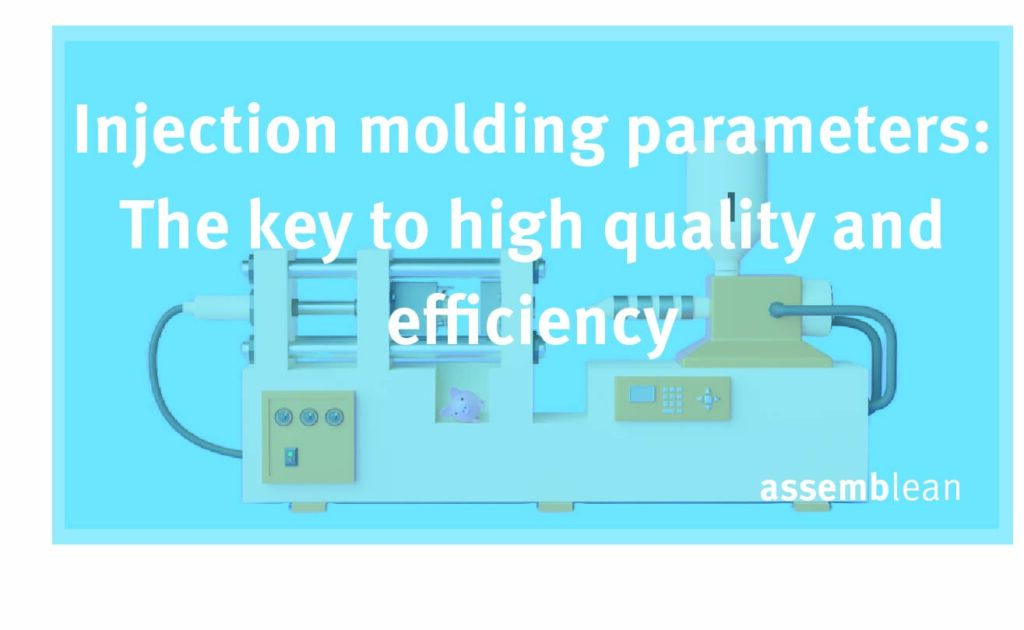Basics of the injection molding process
During injection molding, molten plastic is injected into a precisely manufactured cavity, the so-called injection mold. After cooling, the plastic solidifies and takes on the shape of the mold. The main components of an injection molding system include the injection molding machine, the mold and the plastic granulate. The efficiency and quality of the process depend crucially on the correct setting of the process parameters.Important injection molding parameters and their consequences

Injection pressure
The injection pressure is the force with which the plastic melt is pressed into the mold cavity. An optimally set pressure ensures complete mold filling and prevents air inclusions, which can lead to quality defects such as cavities or poor surfaces. Typically, the injection pressure is between 500 and 2000 bar, depending on the material and part size. However, too high a pressure can cause material stresses and deformation, while too low a pressure can lead to incomplete filling.Melting temperature
The melting temperature of the plastic has a significant influence on its viscosity and flowability. An appropriate temperature is crucial for product quality and process efficiency. Temperatures that are too low can prevent the material from melting completely and spreading evenly, resulting in uneven filling and surface defects. Temperatures that are too high, on the other hand, can degrade the material and impair the mechanical properties, such as the strength and toughness of the end product. For many thermoplastics, the optimum melting temperature is between 180 °C and 300 °C.Tool temperature
The temperature of the injection mold plays a key role in the solidification of the plastic and the surface quality of the end product. An appropriate mold temperature accelerates the cooling time and prevents molding defects such as sink marks and warpage. At the same time, the temperature must be carefully controlled to ensure uniform cooling of all parts of the mold. Typically, mold temperatures are set between 20 °C and 100 °C, depending on the material used and the desired surface properties.Injection speed
The injection speed determines how quickly the plastic melt is injected into the mold. A balanced injection speed is essential for even material distribution and high surface quality. Speeds that are too high can lead to surface defects and sink marks, as the material may not flow evenly and cools quickly. On the other hand, speeds that are too low can lead to incomplete mold filling and air pockets. For most applications, the optimum injection speed is in the range of 50 to 300 mm/s.Holding Pressure
Holding pressure is the force that is maintained after the plastic has been injected in order to compact the mold and compensate for the shrinkage of the material. A correctly set holding pressure prevents warping and ensures stable mold dimensions. Typically, the holding pressure is 70-80% of the maximum injection pressure. Too high a holding pressure can lead to internal stresses, while too low a holding pressure can impair mold filling.Cooling time
The cooling time is the phase in which the injected plastic part cools and solidifies in the mold. Efficient cooling is crucial for the cycle time and the quality of the product. Cooling times that are too short can lead to incomplete solidification and warping, while cooling times that are too long reduce production efficiency. Modern injection moulding machines have optimized cooling systems that ensure uniform cooling and therefore high dimensional accuracy. The use of multiple cooling channels and advanced coolants contributes significantly to reducing cooling times without compromising part quality.Cycle time
The total duration of an injection molding cycle includes closing the mold, injecting the plastic, holding, cooling and opening the mold. Shortening the cycle time can increase the production rate and reduce costs, but must not be at the expense of product quality. The optimum cycle time is a balance between sufficient cooling and maximum production efficiency. By precisely controlling and optimizing all process parameters, the cycle time can be effectively reduced without compromising the quality of the parts.Methods for optimizing the injection moulding parameters
Scientific molding and process optimization
The scientific molding method aims to systematically develop and document the ideal injection process for each injection molding project. By precisely analyzing and adapting the process parameters, product quality can be increased and stable production ensured. This includes the use of statistical methods and continuous improvement processes to better understand the interfaces between different parameters and adjust them optimally.Use of simulations
Simulation software such as Moldflow enables manufacturers to track and optimize the flow of the plastic melt in the mould. These tools help to identify potential sources of error at an early stage and make adjustments before a physical mold is produced. The use of simulations can save time and costs, as molding errors can be avoided as early as the planning phase. In addition, the simulation allows the precise coordination of temperature and pressure profiles to ensure optimal mold filling.Quality control and feedback loops
Regular quality checks and continuous feedback are essential in order to continuously adjust the process parameters and ensure product quality. Modern testing and measuring techniques enable precise monitoring of the manufactured parts. This includes visual inspections, dimensional checks and material analyses to ensure that every part meets the high quality standards. By integrating real-time monitoring systems, deviations can be detected and corrected immediately, increasing the efficiency of the entire production process.Practical tips for setting the injection molding parameters

Furthermore, next to a successful implementation of the injection molding management, the adjustment of the design of the injection molding parts and also the comparison to other manufacturing processes is crucial to produce products with high efficiency in terms of costs and time. Inform yourself here about the optimal design tips and here for the comparison with other processes to identify, when the injection molding is worth it. At assemblean, we automatically make sure to choose the right manufacturing process with the best adjustments possible, and give you feedback if there is space for any other improvement.
Future and trends
The future of injection moulding lies in the further automation and digitalization of processes. Intelligent systems for real-time monitoring and adjustment of injection molding parameters enable even greater efficiency and quality assurance. Sustainability and resource conservation are also playing an increasingly important role, leading to developments towards more energy-efficient machines and recyclable materials. The integration of additive manufacturing technologies into the injection molding process also opens up new possibilities for the production of complex and tailor-made parts. Furthermore, hybrid manufacturing processes that combine injection molding with other production methods will become increasingly important.
Conclusion
Careful adjustment of the injection molding parameters is essential for producing high-quality plastic parts. Through a deep understanding of the individual parameters and their interactions, manufacturers can not only ensure product quality, but also optimize production costs and times. The continuous development of technologies and methods helps to make the injection molding process increasingly efficient and sustainable. Close collaboration between design and production as well as the use of modern simulation and monitoring tools are crucial factors for success.During the entire production process, assemblean always has a specific contact person available to you who forms the interface between you and production. Thanks to both our expertise and your individual requirements, we can always optimize the injection molding processes and design them cost-effectively. Find out more about all the details on our injection molding page or send us one directly a request. We cannot wait to hear from you!
